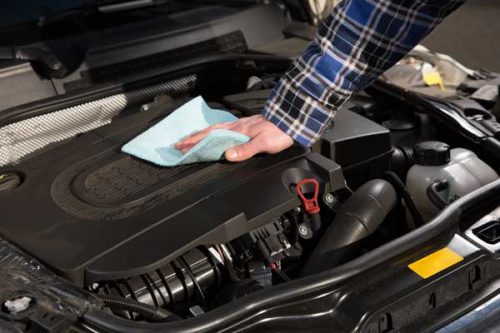Must I wash the engine of my car?
Just in case your engine has the instruction on top to clean it, ensure that you find measures in doing it the right way.
The engine is a very costly component among other parts of your vehicle. Interestingly, people tend to concentrate on servicing and changing other vehicle parts forgetting the significant part, that is, the engine.
Engine cleaning will make a whole lot of difference in your car especially if it has never undergone that process, or has stayed for a long time without going through an overhaul.
It can be messy to clean the engine, therefore ensure you get the proper and legal place to do the job. Get an allowed place to dispose of the dirty water used in the cleaning activity.
Related Read : Best Engine Paints Reviews
Wash your car’s engine and engine bay first, or even a day before washing your car. This will prevent grease and other dirt components from reaching the paint surface of your vehicle and other delicate parts.
An engine that has never been washed or has stayed for a long time without washing will require a lot of duration to get rid of the stubborn grease that has formed.
Grime and oxidation are the major substances that form rust, so ensure that you frequently wash your engine to prevent rust and issues associated with rust.
Maintaining the cleanliness of your engine will improve its lifespan and even that of the car in general. There are different methods involved in this cleansing process. We are going to talk about three of three methods on how to carry out the process.
Procedure One – Plan A
Ensure that you remove any form of debris, such as leaves or small sticks on the surroundings of the engine. Make it thoroughly clear to avoid the chances of creating a fire if they are placed in its surroundings for a long time. The windshield sometimes attracts several substances that transfer into the engine bay.
Disconnect the Battery
The next step is to disconnect your battery. Detach the negative bolt on the terminal, and then carefully move the cable from the terminal.
Exposing your engine bay with water directly could cause fuses to blow or other forms of damages on the electrical parts. It is your choice if you decide to carry and clean the battery away from your engine bay, just be careful while doing it.
In case you don’t wish to remove the battery, put the ground cable aside to separate it from touching in conjunction with the surrounding parts, such as the terminal. When this happens, it could cause a fire or other forms of damages.
Read More : How to Clean Car Battery Terminals
Beware of Naked Wires
The next thing is to ensure is that you are cautious in protecting the naked wires or electronics. Although engines are waterproof, it is necessary to be careful while handling them to avoid further damages from occurring.
Use some plastic to enclose the released wires, the distributor cap, and also the spark plug inlets as forms of precaution measures.
Run the Engine for a While
Give the engine about four to five minutes to run. When there is heat involved, stubborn grease is dealt with seriously. The stuck grease on the grime will come off faster when the engine is running for a while.
Brush of the Grease
Keep in mind not to leave your vehicle’s engine running for a lengthy period of time as you may get burnt while you carry out the cleaning process again.
Brush off the grease with a prickled brush.
So here we go, that is method one of cleaning your vehicle’s engine.
Procedure Two – Plan B
To carry out this plan, you will need an engine degreaser. There are different brands of engine degreasers in the market. The Mckee 37 engine degreaser, Simple Green, Blackfire Engine Decrease are examples of good engine degreasers that you can buy.
Get Your Engine Degreaser
When you decide to use the Mckee 37 brand, ensure that you don’t let it stay on your shinning polish beneath the hood, especially if it is made of aluminum.
This may spot the polished surface of your hood basement. We also have engine degreasers that could be made at home if you would want to be economical.
A mixture of warm water, baking soda and lemon essential oil would make a nice homemade degreaser that will also work wonders for your engine cleaning process. Ensure that you put your home created engine degreaser in a spray bottle to effectively carry out the activity.
Spray on the Degreaser
Carefully spray the degreaser on your engine in a manner that it will settle on all parts. You can also go through the guidelines written on the degreaser you are using and follow as they instruct concerning how you should do the spraying.
Moreover, be careful not to spray the degreaser upon areas that are painted as this can remove or decolorize the paint on your surface.
Spraying in excess will most probably cause the spray to spread to areas that it may affect. In case you have sprayed the engine degreaser on other brightly painted parts, you should rinse off immediately to avoid further damages to those parts.
Spare Some Time to Soak
Give the degreaser time to soak, probably two to five minutes depending on how dirty your engine is. The engine degreaser ensures that it melts down and removes the formed and stuck grease found on the grim of the engine.
For engines that are very dirty, for those that have too much grease, you should let the grease soak for about five minutes before you decide to wash it off. The engines that are not so dirty only require about two to three minutes before they should be rinsed.
Car engine degreasers purchased have instructions that give you the time they need to be left soaked before you start rinsing off, so always read the briefings on the bought product before you start using it.
Some are slow to work, particularly for the grease melting process while others are fast and require little time. However, the longer the duration of time you put the degreaser to perform, the greater the results are.
When the degreaser starts working, it will begin to drip off while carrying along the grease from the engine.
Scrub Off the Dirt
Wear gloves to safeguard your skin from infections and allergies during this next step. Get a firm bristled brush or a toothbrush that is made of steel to brush off any big residuals of grease.
This will be an effortless activity since the degreaser has already lessened the job for you. Be careful to ensure you protect your eyes during this scrubbing activity to avoid the grease from entering inside your eyes.
It is not necessary for you to scrub unless you notice large particles pinned on the surface of the grime.
Rinse with Low-Pressure Water
Rinse the engine with a normal hose. A garden nozzle structured hose can be used to carry out the exercise. It is important to avoid using a hose that exerts a lot of pressure as it may cause the plastic sealings you have made to protect other surrounding parts to come off or even dislocate wires around.
After the whole process, your engine should be grease free and clean. If you still notice some grease remains, spray your degreaser again and give it time to start performing, then rinse it off until you achieve the desired results.
Wipe Clean Your Car
After the decreasing procedure, clean your vehicle instantaneously to make sure that if there was any degreaser that spread to other delicate places, it would be washed off. Utilize different materials while washing the care.
The sponges, containers and rags used should be changed to avoid the spreading of the grease to sensitive parts of the painted surfaces.
Waxing could help in places where the painted areas of your car came in touch with the degreaser.
Procedure Three – Plan C
You can decide to wash the different and specific sections of the engine. Clean the battery terminals with a brush until the moment they are unpolluted. Neutralize using a mixture of baking soda and water if there is corrosion formed due to a leakage from the acid of the battery.
Submerge a brush in the paste and make use of it on the terminals of the batteries and all other parts that may be affected.
On the plastic portions of your engine, use a rigid bristled brush to scrub clean. Also, use soap or a degreaser in the process. Ensure you brush off the grime carefully then rinse off with water.
Brake cleaners destroy grime, and you should, therefore, use it to identify grime remains. Put the straw inside the nozzle of the brake cleaner then point it to areas that have thick remains of slime.
Questions Frequently Asked
1. What are the precautions for handling a brake cleaner?
Brake cleaners are efficient spot removers in the brakes with the ability to vaporize easily. Ensure that you are in an open place when handling it as there are fumes produced in the process.
These fumes can be fatal to your health. Be careful not to have any form of fire around the area you are carrying out this activity. This is because the brake cleaners are highly inflammable.
2. Is it okay if I run a vehicle at the same time I wash the engine using a hose?
No way. This is highly risky. It even seems impossible if you shut the air intake well. Be keen in carrying out any procedure of cleaning and keep in mind areas that aren’t supposed to be touched.
3. How can one avoid rust after cleaning the engine?
Rust is a common substance that simply means bad news for any type of machine. Spray one and a half quart of 5W30 of motor oil.
This is the best method of avoiding rust from destroying your engine since water is involved, a major component that leads to production of rust.
Final Words
In conclusion, handling different parts of your car needs you to be sober and attentive. Make sure you do not damage other parts while cleaning the engine. Cover parts that are electronic to avoid damages when they come in contact with water.

Myself Erick R. Jackson, I am a Computer Science graduate by law but a passionately enchanted blogger by profession.
A few years back, it all started with my first blog website. It was about to deal and heal with automotive hand tools. Well, it brought me a good audience base for sure, which then dragged me out of my major and got me to sit and write, and be a blogger. Read more

